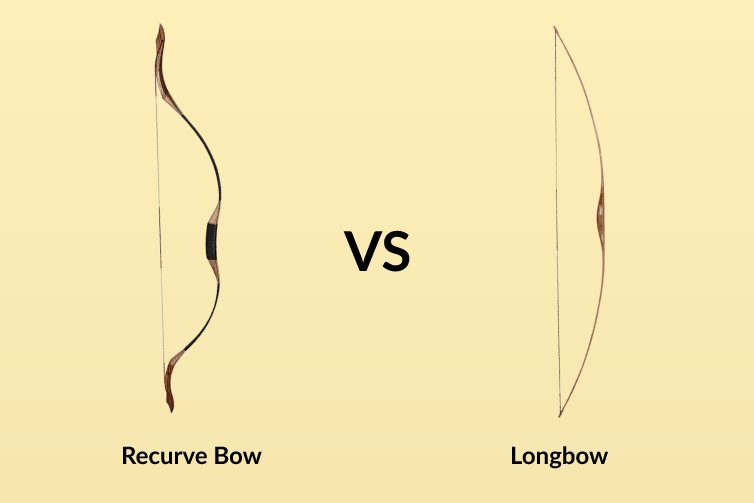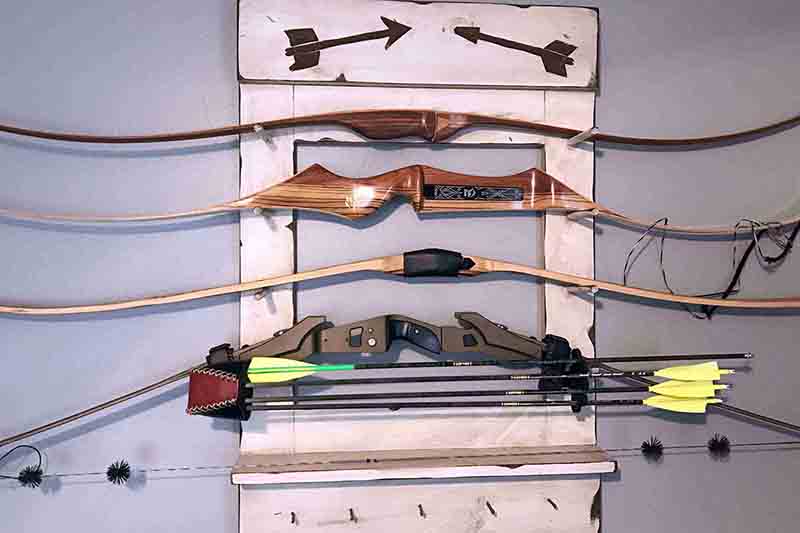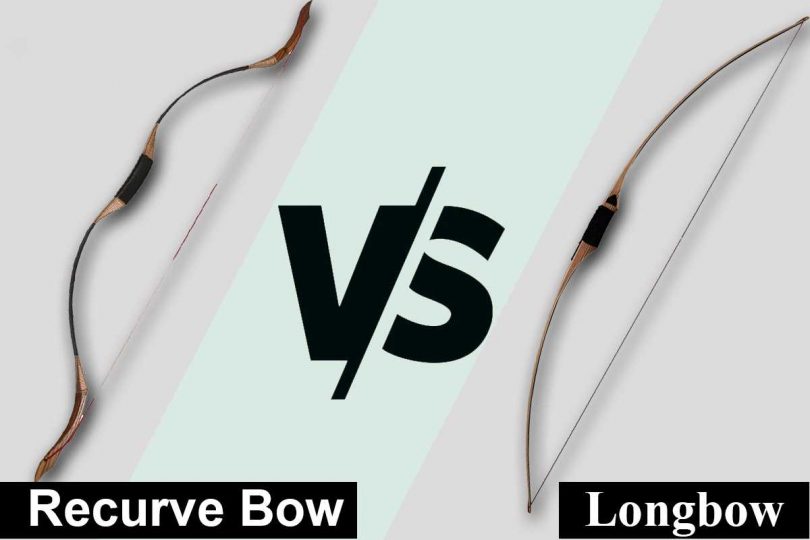The names of the longbow and recurve bow types pretty much describe them. A longbow is the longest of all that currently exists.
The key difference between the longbow and recurve bow types is the size. It is often said that longbows can be characterized as “more forgiving.” On the other hand, a recurve bow is louder but holds more power than a longbow.
In this article, we will compare recurve bows with longbows side-by-side to provide information on the key differences and similarities between these two types.
We will also discuss their origins, design, material, uses, limitations, and benefits so that you can choose the one that best fits your needs and budget.
Let’s explore more differences between recurve and longbows in our in-depth Recurve Bow Vs Longbow comparison!
Recurve Bow vs Longbow – What to Choose

There are many differences between these two bow types. Those include their origin, design, material, uses, benefits, and draw length and limitations.
The care and maintenance requirements are similar but also include some peculiarities. Let’s get into our long bow vs recurve bow comparison right away!
Factor 1: Design
Design is a crucial factor driving the difference between these two types of bow. It directly affects the performance of the bow, not only its appearance. The following sections highlight the key design differences between a traditional longbow and a recurve bow.
Recurve bow
The main design peculiarity you can immediately notice on a recurve bow is the ends of the limbs are curved away from the archer.
How does this key design difference affect the performance of the bow? Thanks to this curve, recurve bows pack more powerful punches than longbows.
In addition, these bows are significantly smaller (shorter) and broader than longbows. They are thinner when it comes to the bow depth.
Longbow
A longbow’s key design feature is the limbs forming the letter “D” with the draw line. You can also think of it as a half-moon, i.e., a crescent shape. There are no curves.
Also, their characteristic peculiarity is their length. These are the longest of all. It is not unusual to see a longbow as tall as the archer!
Moreover, the peculiarities of the longbow design include thinness in its width and thickness in its depth, if that makes any sense!
Recurve bow vs longbow: Testing the difference
Some beginners might need clarification when recognizing the different types of bows. The easiest way to understand if a bow is a longbow or a recurve bow is to check if there is contact between the string and the limbs.
If there is no contact, you’ve got a longbow. If there is, it is a recurve bow.
Also, you can get the underlying differences between them once you calculate their energy delivery into the arrows.
Factor 2: Material
Material is another factor we will analyze on today’s comparison grid.
In the past, both types were made from precisely the same materials – wood and leather. Those were the only available materials.
However, today, we have lots of different materials at our disposal. Let’s see which materials are used for which bow type.
Recurve bow
Modern recurve bows are made from four main types of materials. Those are:
- Carbon fiber
- Wood
- Metal
- Fiberglass
Namely, some recurve bows are made from laminated wood. Others choose a combination of fiberglass, laminated wood, carbon laminations, and metal. The use of new materials did not only make these bows look more modern, but it also increased the accuracy and overall performance of the bow.
Longbow
Most traditional bows (longbows) are made from laminated wood or layered fiberglass. In addition, those made from wood bows sometimes have a carbon center.
As a result, modern longbows are stronger than ever. They are also lighter, which makes them more suitable for contemporary use.
Factor 3: Uses and benefits
Here we come to the part that depicts the most crucial differences between a recurve and a longbow – uses and benefits. Understanding this section will help you choose the most suitable model.
Recurve bow
First of all, recurve bows are more powerful. Thanks to their specific, curved design, you can make compelling shots.
In addition, the winner of the longbow vs recurve speed competition is the recurve bow, which will provide faster arrow shots.
You should use a recurve bow if you want high portability. As this type is significantly shorter than a longbow, you’ll be able to carry it around easily.
In addition, one of the benefits of recurve bows is easy maintainability. We’ll talk more about that in the Care and Maintenance section.
Recurve bows are better if you like to experiment and try new things. Thanks to the high customizability this style of bow delivers, you’ll be able to try on different types of limbs that affect its precision, shooting ease, and power.
Last but not least, the recurve bow is the best choice for traditional archery/target shooting competitions.
If you are an aspiring archer and plan to improve yourself, we recommend the recurve bow. It’s used in international target archery competitions and even in the Olympics.
Longbow
If you are researching longbows, you’ve certainly heard the term “a forgiving bow,” right? What does this actually mean?
Namely, it is easier to use and ensures that the arrow flies comparatively straight, compared to the shots a recurve bow makes. This is why even beginners and inexperienced users can get good results with this bow.
Experts say this bow type is better for beginners, as it is easier to learn the basics of archery properly with the longbow.
No one likes noisy bows. Longbows are quieter in operation. Thanks to that, the longbow is a better choice for hunting. There is significantly less string-limb contact. As a result, you don’t even have to use string silencers if you own this type.
Moreover, you should choose this type of bow if you are keen on historical, traditional, or classic bow styles. This beautiful and appealing bow will satisfy your vintage archery preferences.
Long Bow Vs Recurve Bow For Hunting
Even experts may get confused when it comes to longbow vs recurve for bow hunting comparison.
Namely, both types have their pros and cons regarding this topic. A larger selection of recurve bow is easier to aim and carry around, especially in the forest, thanks to their smaller size.
On the other hand, the longbow is more precise and significantly quieter than the recurve bow, making it perfect for sneak attacks.
Factor 4: Draw length
The difference between the recurve bow and longbow types would not be complete without mentioning the draw length.
It’s imperative to precisely determine your full draw length. It’ll help you become more accurate and learn how to use the bow correctly.
Also, a draw length is usually similar to or the same as the required arrow length. Let’s explore more below.
Recurve bow (H4)
To determine the recurve bow draw length, we recommend you use the following method.
Draw Length = Arm Span ÷ 2.5
Measure your arm span. Divide the result by 2.5.
You will get a result in inches; this is your perfect draw length based on your arms.
Longbow
It is the length you get when you measure the distance between the throat grip and the nock point and add 1 ¾ inches to that value.
Factor 5: Limitations
We have pointed out both types’ advantages, uses, and benefits. Now, let’s talk about the limitations and drawbacks.
Even though bow experts sometimes have different opinions on certain factors, we will provide insight into the most common and widely accepted statements.
Recurve bow
The most obvious limitation of the recurve bow is its limited precision. Even the best recurve bows are less precise than the standard longbows.
In addition, these bows are precise only if the archer is very experienced. This limitation results from thinner limbs and the fact that you must draw the string far back to generate more power.
Another limitation of the recurve bows is the noise they generate. If you don’t have string silencers, this will limit your performance in hunting. This results from lots of contact between the limbs and the string.
String slap is another common issue with traditional style bows. It’s when the string slaps against your arm when drawing the bow. However, there are techniques to avoid this.
Longbow
There are also several limitations to longbows. First of all, the Achilles heel of longbows is power. Of course, longbows are very powerful tools, but they are beaten by the recurve models. This is why longbows can’t outperform recurve bows regarding arrow speeds.
Another limitation peculiar to this bow type is portability. As longbows are large, they are only suitable for carrying around all day long in the woods. Also, takedown models are rarely seen.
Factor 6: Care and maintenance requirements

Whether you use a recurve bow, a longbow, a compound bow, or even a crossbow, you need to take good care of it in all cases.
Neither the recurve bow nor the longbow is very demanding regarding the re-stringing. You can easily do it yourself.
In addition, you don’t need any special machines, devices, or tools to do that. You can re-string both bows by hand.
However, the situation is a bit more complex when it comes to repairs. Let’s explore why.
Recurve bow
When it comes to repairs, the obvious winner is the recurve bow. Why?
Simply put, you don’t have to worry much even if your recurve bow is broken. Thanks to their amazing customizability, you can buy new limbs and use your bow again.
This is especially true if you have a takedown model. Therefore, the easiest one to repair is the recurve bow.
Longbow
Unfortunately, once a longbow is broken, you cannot do much. They’re often single-piece bows, and repairing them is not very easy. Even if you do, the quality and performance remain questionable. That’s why it’s better to get a new one.
Conclusion
It is not easy to understand the difference between the longbow and recurve bow without actually putting them into action. Both have their advantages and disadvantages.
Some important factors you must consider before choosing your bow type include the intended use, preferences regarding style and tradition, and aspirations toward international competitions.
If you value accuracy, style, and quiet operation, we recommend you get a longbow. It is also recommended for beginners.
On the other hand, if you want to join competitions and value faster and more powerful bows, the recurve type is the most suitable pick.
We hope all the information in this article will help you decide whether the longbow or recurve type is the best choice.
FAQs
How Far Can A Longbow Shoot?
A little over 350 yards. How fast your bow can shoot depends on factors like the grain weight, the draw weight, wind draft, and many more. The effective shooting range of a longbow is around 250-300 yards. However, experience shooter can shoot accuratly even over 400 yards.
Why Is My Bow Hitting My Arm?
This is called “string slap” and it’s a common issues for traditional archers. This happens when you release the arrow and the string hits the soft tissues in your arm. This happens due to bad posture and less body flexibility. Here’s how you can tackle that.
What Parts Of A Bow Are Most Commonly Damaged?
The bowstring. This is the part of your bow that faces the most wear and tear, and you’ll need to change the string frequently. It’s a common tendency to put too much strain on the bowstring, causing it to fray and snap.









Leave a Comment